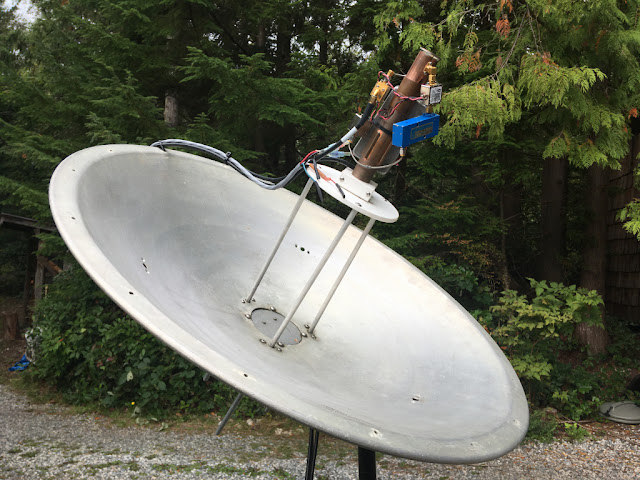On Oct. 4th, amateur radio operator
Scott Tilley picked up
a carrier wave from NASA's Mars Reconnaissance Orbiter (MRO) circling the
Red Planet.
Earth and Mars are pretty much at opposition now, and the closest
approach since 2003, so he had that working for him. Still, at the point
of closest approach on October 6,
the red planet was 38.6 million miles away. How much signal is lost over that distance?
The free space path loss is computed with the expression:
dB = 37 dB + 20log(f) + 20log(d)
Here, f is the frequency in MHz and d is the distance in miles.
That says the path loss is 37+ 20log(10,000) + 20log(38.6x106) or
266 dB
Off the top of my head, that implies a lot of antenna gain on both ends.
We don't know about the details on the MRO orbiter, but we know the hardware
Scott used. This dish measures a mere 60 cm aperture - 23.6 inches. Using a standard formula I get about 33 dBi gain from an antenna this size. Very high gain compared to a typical ham's Yagi beam but since gain is a function of diameter, it pales compared to the gain NASA gets on much bigger antennas.
Still, let's say that NASA put the same gain antenna on the MRO. That's 66 dB gain between them and that turns the path loss into 200 dB. Start with about 1 Watt at the transmitter and the signal comes out around the thermal noise floor in a receiver. I'm sure this BOTE (Back Of The Envelope) arithmetic must be overlooking something, but it seems close.
Scott Tilley's hobby is looking for satellites. Sometimes presumed
dead, sometimes kept hidden. Spaceweather puts it this way:
Tilley is a leader in the field of satellite radio. Dead satellites,
zombie satellites, spy satellites: He routinely
finds and tracks them.
"But this was a first for me," he says. "A satellite around Mars!"
It's not easy picking up radio signals from distant planets. NASA does it
using the giant antennas of the Deep Space Network. Tilley uses a modest
60 cm dish in his backyard in Roberts Creek, BC. This week's close
encounter with Mars set the stage for his detection.
"MRO's signal is weak, but it is one of the louder signals in Mars orbit,"
says Tilley. "The spacecraft has a large dish antenna it uses as a relay
for other Mars missions. With the proximity of Mars these days, it
was the perfect time to try."
That link is to his personal web page,
Riddles in the Sky. Not updated very often, his
Twitter feed seems to be his emphasis, but both are full of nerdy goodness. I've stumbled across web references to guys who search for satellites before and never paid it much attention. This is pretty cool.

At that dish size and frequency, what would be the angular coverage?
ReplyDeleteI get about a 3.5 degree beam width (at -3 dB). Comparatively, Mars is tiny, even at its maximum which is about 22.5 arc seconds this year.
DeleteStill, it would seem that Stilley's antenna would have to be motor driven if he needs to observe Mars for any length of time. Objects in the sky move at half the rate of the hour hand on a clock, going 180 degrees (from 3:00 to 9:00) in 12 hours instead of six, but that 3-1/2 degrees is about 15 minutes of observation.
I'm curious as to why the frequency is there in your path-loss equation?
ReplyDeleteThe 1/r^2 term ( 20 log(d) ) makes sense, but why would there be a dependence on frequency in a vacuum where nothing is absorbing the beam? It isn't some sort of sender-gain thing because you don't have any sender details.
MadRocketSci
Every path loss equation I've ever seen has that direct dependence on frequency, i.e., loss goes up as frequency goes up. In reality, all radio frequencies drop off with distance as 1/(distance squared) so there's no dependence on frequency. The wavelength effect is due to the model of an antenna aperture that's embedded in the assumptions. I use these relationships because it's easy to add and subtract antenna gains in dB for the systems engineering.
DeleteThis discussion may help clear it up, I hope.